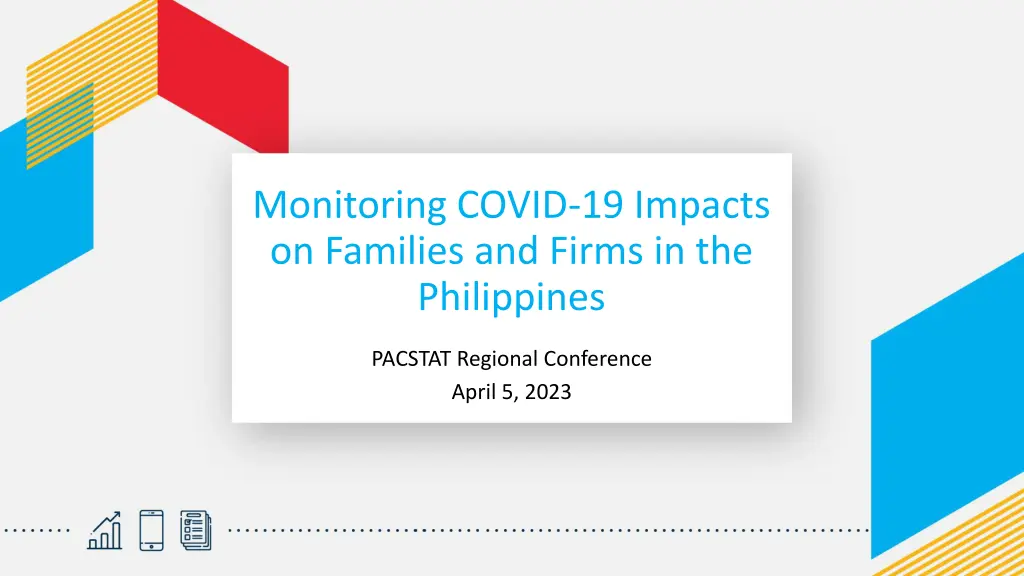
Real-Time Monitoring of COVID-19 Impacts on Families and Firms in the Philippines
Explore the comprehensive approach to monitoring COVID-19 impacts in the Philippines through surveys on firms, households, and communities. Get insights into the implementation rounds and survey samples to understand the situation better.
Download Presentation

Please find below an Image/Link to download the presentation.
The content on the website is provided AS IS for your information and personal use only. It may not be sold, licensed, or shared on other websites without obtaining consent from the author. If you encounter any issues during the download, it is possible that the publisher has removed the file from their server.
You are allowed to download the files provided on this website for personal or commercial use, subject to the condition that they are used lawfully. All files are the property of their respective owners.
The content on the website is provided AS IS for your information and personal use only. It may not be sold, licensed, or shared on other websites without obtaining consent from the author.
E N D
Presentation Transcript
Monitoring COVID-19 Impacts on Families and Firms in the Philippines PACSTAT Regional Conference April 5, 2023
Philippines Real Time Monitoring of COVID-19 Impacts Firm Surveys Self-administered web survey to monitor impacts on firms operations, sales and employment as well as adjustment mechanisms Household Surveys Phone and self- administered web survey to monitor welfare changes in households Community Surveys Qualitative surveys to better understand local context and to identify most vulnerable groups
Implementation Round 1 Round 2 Round 3 Round 4 Firm Apr 2021 Firm Mar 2022 Firm Firm Jul 2020 Community Aug/Sept 2020 Dec 2020 Household & Community Mar 2021 Household Aug 2020 Household Dec/Jan 2021 Household May 2022
Survey sample Round 1: 26,953 respondents (CAWI: 24,391, CATI: 2,562) in urban/rural and across all regions 9,448 final sample Round 2: 3,500 sampled respondents from round1 1,805 completed interviews Round 3: 5,121 sampled respondents from R1 2, 122 completed interviews Round 4: 1,954 respondents completed the survey With augmented samples done in CAPI and CATI Household Firm Community Round 1: 74,031 respondents (all regions) 37,669 final sample Round 2: 30,395 respondents (all regions) 13,878 final sample Round 3: 6,611 respondents (all regions) Round 4: 3,839 respondents (all regions) Round 1 180 respondents in 101 barangays Sample was drawn from the National CDD Program beneficiary list Coverage limited to rural barangays Round 2 200 respondents in 135 barangays
Survey sample Household Firm Community The sample was weighted using the Survey of Wellbeing via Instant and Frequent Tracking (SWIFT) tool to place each household in the income distribution to match the 2018 FIES No weights used as this was more qualitative in nature Sample was reweighed to follow the distribution of firms by region and firm size based on employment as reported by the Philippine Statistics Authority s 2018 Listing of Establishments
Womens employment has improved, but gaps remain Employment among women has shown a slight improvement, increasing from 56% in May 2021 to 59% in May 2022. Share of Respondents Reporting to Work, by Gender 80 74 74 72 70 67 65 58 61 60 64 Women s employment rates were higher in May 2022 than pre-pandemic. 59 51 50 56 47 40 30 However, the gender gap in employment remains persistent, as the share of male respondents reporting to work continue to be 15 percentage points higher than for female respondents. 20 10 0 Aug 2020 Dec 2020 May 2021 May 2022 All Female Male
Women increasingly use home-based and flexible work arrangements In May 2022, nearly 40% of women were working from home and about 5% resorted to hybrid work. Work arrangement by gender and HFS round 100 80 22 29 19 36 40 31 29 60 35 39 26 32 36 Men are returning to office at a higher rate than women, but about 30% use home-based or hybrid work modes. 40 59 58 54 48 48 47 45 42 20 40 39 37 35 0 Female Female Female Female All All All All Male Male Male Male Aug-20 Dec-20 May-21 May-22 Work as usual - office Work as usual - home Not able to work as usual Mixed home & office work
Family responsibilities continue to affect womens work Caring for children or sick family members affects women s decision to work at far greater rates than men. Main reason women are not working- May 2022 100 The effect of care work on women s work is particularly high among women in poor households with young children under 4. 80 60 However, the effect of care work on women seems to be reducing compared to May 2021, when the share of women not working due to family responsibilities was 31%. 48 40 2 36 27 20 7 This could be in part due to the gradual reopening of in-person instruction which began in February 2022 and/or the expansion of home-based work. 0 Poorest quintile Richest quintile Total Men Women Women with young child COVID-19 related Bus.closed/seasonal Care child/ill Other
